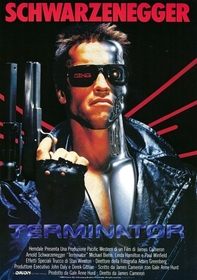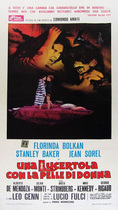Our editor-in-chief Nate Yapp is proud to have contributed to the new book Hidden Horror: A Celebration of 101 Underrated and Overlooked Fright Flicks, edited by Aaron Christensen. Another contributors include Anthony Timpone, B.J. Colangelo, Dave Alexander, Classic-Horror.com's own Robert C. Ring and John W. Bowen. Pick up a copy today from Amazon.com!
The Terminator (1984)
At first glance, James Cameron’s The Terminator would appear to be only tenuously connected with the horror genre. After all, it’s a sci-fi action-thriller, not to mention one that spawned two decidedly non-horror sequels. Sure, it has a ruthless killing machine methodically hunting down a single target without thought or concern for his own well-being, but… wait. Back up. That is a horror film plot. The time travel concept and the post-apocalyptic flash-forwards are all window-dressing that masks the fact that The Terminator is very much a slasher movie, just one with guns and explosives instead of hatchets and chainsaws.
A pre-credits text intro lets us know that the aftermath of a future nuclear war has pitted man against machine in a battle for survival, but that the resolution of this conflict will take place in our time. Our time, incidentally, is 1984 (as evidenced by the bad hairdos and ridiculous clothes) and the two combatants are an unnamed cyborg Terminator (Arnold Schwarzenegger) and Kyle Reese (Michael Biehn), a soldier from the 21st Century. The Terminator has traveled back in time to kill Sarah Connor (Linda Hamilton), the mother of the yet-to-be-conceived leader of the future human resistance, while Reese has arrived to protect her.
It’s such a simple, elegant premise -- two men, one nigh-unstoppable and one all too mortal, playing a game of keep-away with the life of a woman with a destiny. It requires no further twists to play out, and Cameron is wise to avoid the temptation. Any additional idea would have also lead to additional exposition, an area where Cameron is clearly uncomfortable, given that most of the pertinent plot facts are established by Reese in a long-winded, almost uninterrupted monologue one-third of the way through the film.
In many ways, The Terminator comes into the slasher genre not by adhering to its common elements, but by subverting them. The muscle-bound hunk with the lantern jaw isn’t the hero, but the villain, and he starts out with the appearance of humanity until his “mask” of flesh is ripped away to reveal the truly inhuman visage beneath. Conversely, the lean, scarred and sweaty stranger surreptitiously tailing Sarah Connor is the real good guy. Instead of the wide variety of close-and-personal bladed instruments, the Terminator uses an equally diverse array of impersonal rifles, handguns, and semi-automatic weapons. Dark secluded houses with labyrinthine hallways are disposed of in favor of open warfare on the streets of Los Angeles and the outlying areas. Take almost any element of the slasher movie and you’ll find its antithesis in The Terminator. The near-complete reversal creates an unconscious identification – a mirror image, if you will - that reflects the conventions that we’re used to, flipping them around.
Of course, like every reflection, no matter how warped the image, there must be points of commonality with the reflected subject. The Terminator adheres to two of the main slasher conceits. First, and most obviously, it follows a single-minded killer who offs a series of victims. The Terminator even follows a specific pattern – murdering Los Angeles-area Sarah Connors in the order in which they appear in the phone book. Second, The Terminator clings almost religiously to the concept of the Final Girl. As Carol Clover, who coined the term, describes it, the Final Girl is a female who “alone looks death in the face … she alone also finds the strength either to stay the killer long enough to be rescued (Ending A) or to kill him herself (Ending B).”1 Sarah Connor fits this mold perfectly, especially in regard to Clover’s “Ending B”. She comes into the film an innocent, and leaves it wiser and perhaps a little more dangerous, having destroyed the monster with his own weaponry – a piece of machinery. This journey would be more perfectly elaborated on in the decidedly non-horror sequel, Terminator 2: Judgment Day, where we find that Sarah has become a hardened warrior preparing her son for the coming apocalypse.
Cameron’s direction throughout the film is highly indicative of his skill at making high-octane action films. He keeps the adrenaline pumping and the tension mounting as he launches gun battle after car chase after gun battle. His editing is precise and quick without calling attention to itself or distracting from the events on-screen. Cameron rarely dips into any sort of self-indulgence; his interest is clearly in the plight of Sarah and Kyle, and that transfers to the audience. When Sarah is running from a semi truck driven by the Terminator, it’s a well-paced sequence with strong direction, but it’s the concern for the characters with which Cameron has imbued the film that really has us going.
You can’t talk about The Terminator without talking about the Terminator. Schwarzenegger may not have many lines, but boy does he have presence. From the first moment we see his naked, freakishly muscled body, we sense we’re in the presence of a very dangerous person. When he dispatches a trio of punks (including a very young Bill Paxton) to get their clothes, our suspicions about his menace are confirmed, but we’re also proved quite wrong about his personhood. As he punches through one of the punks’ torsos, we realize that the Terminator is, as Reese later describes him, “a killing machine, without emotion, without pity, and without remorse.” Schwarzenegger’s staccato (or robotic?) delivery of his lines, largely the result of the actor’s limited command of the English language, only adds to his performance.
Stan Winston, credited with “Special Terminator Effects”, uses his special brand of makeup and technical wizardry to bring the robotic aspects of Schwarzenegger’s character to life. Using a combination of model work, facial prosthetics, and animatronics, Winston is mostly successful in selling the illusion of a robot walking among us. Some of the animatronics meant to look like Schwarzenegger are just inaccurate enough to be noticeable, however, but otherwise, it’s top-notch work and highly commendable.
One of the definitive action flicks of the 1980s – or any decade really – it’s easy to forget that The Terminator is one of the more thrilling horror films ever made. While it’s rarely out-and-out scary, the same can be said for several films from the same era that promise a terrifying experience in their advertising. You can draw the line anywhere you want, but for my money, The Terminator is a movie that stands proudly next to other horrific actioners like George A. Romero’s Dawn of the Dead and Cameron’s own Aliens.
- Clover, Carol J. Men, Women, and Chainsaws: Gender in the Modern Horror Film. Princeton University Press, 1992. Page 35.









this should be remade in
this should be remade in modern terms. The terminator would? have an iphone and sarah would be dead in like 7.5 minutes.